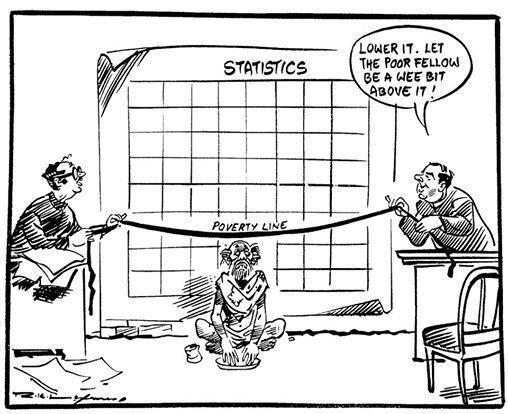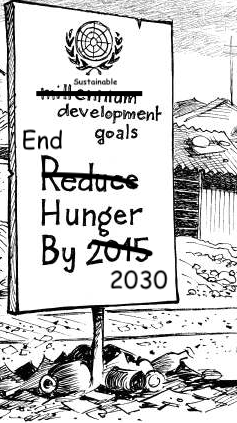Who Are the Worldâs Poor? New overview from CGD
 Guest post from Gisela Robles and Andy Sumner
Guest post from Gisela Robles and Andy Sumner
It sounds like a simple question: Who are the worldâs poor? Farmers, right? Well, yes, but not only. In a new CGD working paper, Gisela Robles and I take a closer look at the data on global poverty to answer this question in finer detail. We find that when poverty is measured over multiple dimensionsâincluding education, health, and standards of livingâidentifying the global poor reveals some important findings.
Measuring poverty
The World Bankâs new global poverty line is $1.90 per day. Using this measure, there were an estimated 766 million people living in âextreme povertyâ in 2013. Castañeda et al. (journal version and ungated) find those living under $1.90 a day are primarily rural, young, and working in agriculture.
But if what if we consider dimensions of poverty beyond monetary measurements by looking at things like poor schooling, ill health, and malnutrition? Does the global poverty profile change? Put another way – with the UN global goals to end poverty in mind – what needs ending and for whom by 2030?
In our paper, we present a new global poverty profile using the multidimensional poverty measure developed by Sabina Alkire and James Foster at the Oxford Poverty and Human Development Initiative. We estimate a new global poverty profile for multidimensional poverty in 2015 based on 106 countries that account for 92 percent of the developing worldâs population.
Here are our three main findings:
The worldâs poor are young, often children but not necessarily farmers
First, at an aggregate level, the overall characteristics of global multidimensional poverty are more or less similar to those of global monetary poverty at $1.90 per day. In both cases, poor households tend to be rural households formed predominantly by young people.
Half of the worldâs multidimensional poor are under 18 years of age. Yes, you read that right. And three-quarters are under 40 years old.
We find, in countries which have the data, that two-thirds of poor households have a member employed in agriculture, but surprisinglyâgiven incomes are likely to be higher outside agricultureâone-third of poor households have no member employed in agriculture.
In other words, it turns out at least in the countries that we have data for that a significant proportion of the worldâs poor arenât farmers.
And a thought for those who say global poverty effects only 1 in 10 of the worldâs population: among the most frequent poverty deprivations, we find that undernutrition affects 1.5 billion peopleâdouble the $1.90 global poverty headcount.
Rural poverty is more about infrastructure. Urban poverty is more about child mortality and food
Second, at a disaggregated level, we find that poverty in rural areas tends to be characterized by overlapping deprivations in education and
access to decent infrastructure, meaning water, sanitation, electricity, and decent housing.
In contrastâand counterintuitively given the proximity, in principle, to better healthcare and economic opportunitiesâit is child mortality and malnutrition that is more frequently observed within urban poverty.
Just how multidimensional poverty is depends on where you live
Finally, the extent of the multidimensionality of poverty differs substantially by region; moreover, some deprivations frequently overlap while others do not.
The infrastructure-related dimensions of povertyâwater, sanitation, electricity, and housingâoften overlap with each other. No surprise thereâit is easy to imagine that people who live without access to clean water, for example, might also lack access to sanitation.
What is surprising is that deprivations in health indicators overlap least frequently with other dimensions of poverty. This points towards the importance of giving health poverty direct attention in policy.
Why does it all matter?
So where do the numbers take us? Â If many of the worldâs poor are outside of agriculture, and the urban poor experience malnutrition and child mortality despite better economic opportunities in principle, then what is going on?

First, the good news: most of the worldâs multidimensional poor live in countries with good growth history. In fact, three-quarters of global multidimensional poverty is in fast-growing countries (see table below).
So, no need to worry as growth will take care of poverty in due course? Youâd think growth was always good for the poor, right?
Well, in a very general way, yesâbut with some big caveats. In terms of monetary poverty, in up to one-third of growth episodes monetary poverty rates may not fall, as highlighted in a new book edited by Ravi Kanbur, Paul Shaffer, and Richard Sandbrook. And it seems the link between economic growth and multidimensional poverty is weaker still, as Santos et al. find (journal version and ungated).
Part of the story may be the different kinds of growth episodes. One interesting new theory is that of UNU-WIDERâs Kunal Sen (journal version and ungated), who separates types of growth episodes into âgrowth accelerationâ and âgrowth maintenanceâ and finds that the former is much less likely to benefit the poor than the latter. He argues that this is because the institutional factors that lead to growth accelerations are different from those that lead to growth maintenance.
What that study, the new book, and our own findings point towards is that itâs a good time given the global goals on ending poverty to take a much closer look at when growth goes right and wrong for the poor, and why.
Where do the multidimensionally-poor live? The global distribution of multidimensional poverty by growth history of country, 2015.
GDP per capita, PPP
(constant 2011 international $), average annual growth, 1990â2016
Number of countries
% of global
multidimensional poverty
25
13.4%
1% – 2% per capita/year
22
11.1%
>2% per capita/year
59
74.8%
No data
5
0.7%
Total
111
100.0%
Source: World Bank, World Development Indicators 2018 for GDP per capita growth rates and population figures; Robles and Sumner (2018) for MPI data. Note: Includes 111 low- and middle-income countries with populations above 1 million people.
The post Who Are the Worldâs Poor? New overview from CGD appeared first on From Poverty to Power.

Duncan Green's Blog
- Duncan Green's profile
- 13 followers



